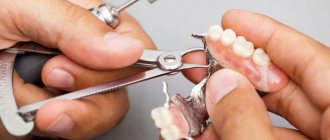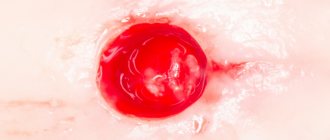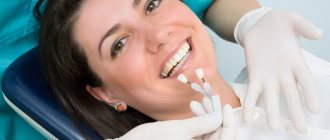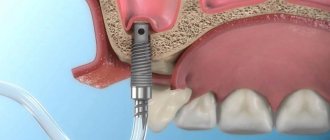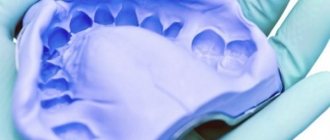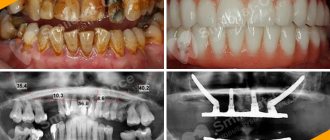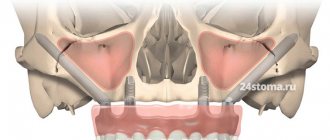More and more patients are turning to the dentist to restore all their teeth, or one jaw completely. Conventional removable dentures, partial dentures and extended metal-ceramic bridges do not meet the high requirements for comfort, aesthetics and durability. All of these goals can be achieved with dental implants.
The technique of jaw implantation in the absence of teeth is significantly different from implantation in the absence of only a few teeth. For example, it is an obvious fact that you do not need to install 32 implants to restore all your teeth. All the details of full dental implantation are outlined in this article.
Methods of prosthetics on implants in the absence of teeth
Prosthetics on implants in the absence of teeth can be divided into 3 types: removable, fixed and conditionally removable.
Removable prosthetics on implants is suitable for those patients who have already used a removable denture, but could not get used to it. Any option of removable prosthetics on implants will greatly improve the quality of life of such patients.
However, if you have never used a removable denture, then psychologically it will not be easy to get used to such a design. In this case, the best option would be fixed or conditionally removable prosthetics on implants. Conditionally removable means that the prosthesis is fixed with screws. It can only be removed by a dentist; the patient uses it as if he were his own teeth.
Implantation of both jaws with simultaneous loading with plastic crowns
More details about each treatment method are described later in this article.
Advantages of full implantation in terms of ease of eating
If we compare chewing efficiency with classic removable prosthetics and with implant-supported prosthetics, in the latter case it increases significantly, and, as is known, the quality of chewing food affects the condition of the gastrointestinal tract and the body as a whole. Owners of complete removable dentures have to regularly contact a gastroenterologist, who can only offer them to put food through a blender, but any person wants to eat well.
It is also worth noting that the process of chewing with the help of a complete removable denture constantly causes pain, since the structure puts pressure on the mucous membrane, under which there is a periosteum with many nerve endings. When the denture is installed supported by implants, there is no pain, since there is no pressure on the soft tissues.
Lower jaw implantation
The lower jaw is denser in structure than the upper jaw, so in most cases, 2 to 6 implants are enough to restore all teeth. The integration period for implants in the lower jaw is 3 months.
Removable prosthetics on implants in the lower jaw are carried out on 2-4 implants. The most common option is to install 4 implants with spherical attachments (or locators). The advantages of this method are good fixation of the prosthesis, easy oral hygiene, simplicity of design, and, as a result, its low cost. A removable prosthesis on 2 implants with attachments is used in cases where there is not enough bone tissue to install 4; the fixation of the prosthesis in this case is worse. The disadvantages of this treatment method are that the prosthesis distributes the load not only on the implants, but also on the gums. Under the pressure of the prosthesis, the gums atrophy, so it is necessary to reline the prosthesis on average once a year. The fastening on the attachments also weakens; it is necessary to periodically replace the retention matrices. The service life of the prosthesis itself is about 5 years.
Removable denture on 4 implants with spherical attachments on the lower jaw
The second option for a removable prosthesis on the lower jaw is prosthetics of the lower jaw on a beam on 4 implants. In this case, the load is distributed mainly on the implants and much less on the gums. The fixation of the prosthesis is very tight, the prosthesis feels almost like your own teeth. The prosthesis itself is made of plastic. It completely restores aesthetics and chewing function. The fact that the denture is removable simplifies oral hygiene. A plastic prosthesis is not as rigid as a metal-ceramic or zirconium one, so it is easier for people who have problems with the temporomandibular joint to get used to it. The disadvantage of this treatment method is that a properly manufactured beam prosthesis is comparable in cost to a fixed structure.
One of the main conditions for the long-term functioning of such a prosthesis is that the beam connecting the implants must be very accurately connected to them. For this, multi-unit abutments are used, which ensure precise connection of the implant with the beam; the beam itself must be made on a milling machine. Unfortunately, patients are often offered a bar prosthesis made without multi-unit abutments, or made by casting rather than milling. In this case, the beam will be fixed to the implants with tension, which will lead to a negative result, possibly even to the loss of the implants due to their overload.
Removable denture on a beam fixation on the lower jaw
Fixed prosthetics of the lower jaw are performed on 6 implants with classical implantation. It is also possible to restore teeth on 4 implants using the all-on-4 method, in which case 2 of the 4 implants are placed at an angle of up to 45 degrees. The technique has its pros and cons. All-on-4 will be written about later in this article.
Fixed prosthetics completely imitate your own teeth and are the easiest to tolerate psychologically. During the period of implant integration, the patient uses a temporary removable prosthesis, or dental implantation is carried out with a simultaneous load using a fixed plastic prosthesis. The service life of a plastic prosthesis is 1 year. It can be replaced with metal-ceramic or zirconium after the implants have completely healed. On the lower jaw after 3 months. The implants themselves are not affected.
In the case when a permanent prosthesis is made with screw fixation, we are talking about conditionally removable prosthetics on implants. Conditionally removable means that the prosthesis can only be removed by a dentist. The patient cannot remove it on his own; it feels and functions like his own teeth.
The advantages of screw fixation are that the prosthesis can be removed if necessary. Unlike cemented dentures, which cannot be removed without sawing them. However, the complexity of the design, and as a consequence the cost, is increasing.
Fixed denture on the upper jaw on 6 implants, on the lower jaw on 6 implants
Advantages and disadvantages
These implantation protocols are an excellent alternative to natural teeth. The main advantage of these methods is time saving, that is, performing basic manipulations in 1 day. A person gains a new smile in 2 visits to the clinic.
Additional advantages of protocols:
- immediate restoration of chewing function;
- there is no risk of the orthopedic complex falling out;
- there is no need to prepare (grind) the remaining teeth;
- have excellent aesthetic properties, the work performed is absolutely invisible;
- carried out immediately without building up lost bone tissue;
- after the intervention, swelling of the face does not develop;
- comfortable adaptation to the temporary structure;
- sufficiently long service life;
- no diction problems.
The main disadvantages of one-stage implantation are the high price and the risk of complications, which include the appearance of inflammatory processes and implant rejection. Risks can be minimized by choosing a clinic with a good reputation and a guarantee for both the implant and the treatment itself.
Upper jaw implantation
The bone tissue of the upper jaw is less dense than that of the lower jaw, therefore, for complete prosthetics on implants in the upper jaw, more implants are needed - from 4 to 8. Healing of implants in the upper jaw occurs within 6 months.
Removable prosthetics of the upper jaw are performed on 4-6 implants. On 4 implants it is possible to install an overdenture with spherical attachments. The overdenture has the same boundaries as a regular removable one; it completely covers the palate. To make a prosthesis on the upper jaw without a palate, you need to install 6 implants. Ball-shaped attachments, locators or a beam can be used as connecting elements. The best fixation of the prosthesis is achieved on a beam. However, the cost of such a prosthesis is comparable to a fixed structure.
For fixed prosthetics of the upper jaw, it is necessary to install from 6 to 8 implants. It is also possible to install a fixed denture on the upper jaw on 4 implants using the all-on-4 technique. It will be written about later in this article.
Installing 6-8 implants in the classical way is the most studied and reliable option for implanting the upper jaw. The number of implants is determined by the presence of bone tissue and the shape of the upper jaw. While the implants are healing, the patient uses a temporary removable prosthesis, or implantation is carried out with a simultaneous load using a fixed plastic prosthesis.
The service life of a plastic prosthesis is 1 year. It can be replaced with metal-ceramic or zirconium after the implants have completely healed. On the upper jaw after 6 months. The implants themselves are not affected.
Just like in the lower jaw, in the upper jaw it is possible to make a permanent screw-retained structure - conditionally removable prosthetics. Only a dentist can remove a screw-retained prosthesis. The patient uses it as if he were his own teeth.
The advantages of screw fixation are that the prosthesis can be removed if necessary. Unlike cemented dentures, which cannot be removed without sawing them. However, the complexity of the design, and as a consequence the cost, is increasing.
Different implantation options for complete absence of teeth. 8 implants on the lower jaw, 6 implants on each jaw, 8 implants on the upper jaw
What determines the cost of prosthetics?
How much does tooth replacement cost? To answer the question, you need to take into account that there are various options for restoring the dentition. They differ in design characteristics and cost, which depends on the type of prosthesis, the material from which it is made, and the work of the doctor.
Prosthetics are carried out using removable and fixed dentures and implants.
Removable prosthetics:
- dentures made of acrylic - the most budget type of design (the price consists of the cost of manufacturing and installation);
- Clasp removable dentures are more expensive (the price depends on the coverage area and the method of attachment).
Fixed prosthetics:
- artificial crowns made of metal (available, cheap, but not very aesthetically pleasing method); metal ceramics (reasonable cost and high aesthetics); ceramics (highly aesthetic, the most expensive will be a product made of zirconium dioxide);
- bridge structures - metal-ceramic, ceramic (made of expensive zirconium dioxide) and adhesive (the cheapest option);
- inlays (from cheap porcelain to expensive alloys of precious metals);
- ceramic and composite veneers (porcelain has the lowest price, zirconium dioxide has the highest price).
Pricing for prosthetics using implants includes the cost of:
- preparatory period (detailed diagnostics, modeling, preparation of bone tissue);
- implantation surgeries (includes the cost of the implant and abutment, anesthesia);
- prosthetics (installation of crowns).
At NovaDent clinics, prosthetics are performed using the All-on-4 and All-on-6 methods, using fewer supports for installing the prosthesis.
We work every day. Contact your nearest NovaDent clinic to find out how much it costs to replace a tooth. The doctor will suggest a treatment method and inform you about the cost of the work.
The addresses of all NovaDent clinics in Moscow and the region are listed on the website. Here you can also find the price list for dental services and information about current promotions and special offers. There is an installment plan for complex treatment; it is possible to pay for implantation on credit.
Expert of the article you are reading: Kuzmenko Viktor Valerievich Orthopedist, surgeon, leading specialist of the NovaDent network
16 years
Clinical experience
Krasnogorsk
Moscow region, Krasnogorsk, Podmoskovny Boulevard, 5
+7
Free consultation with this specialist
All-on-4
The All-on-4 technique (all-on-four) was developed by Nobel Biocare. It involves the installation of 4 implants on one jaw with simultaneous loading with a fixed prosthesis on a screw fixation. The 2 outermost implants are placed at an angle of up to 45 degrees, which allows you to bypass anatomically difficult places: the maxillary sinuses in the upper jaw and the nerve exit site in the lower jaw.
Initially, the All-on-4 technique was positioned as minimally invasive, without bone grafting. However, for successful functioning it is necessary to install sufficiently long implants, because 4 implants must bear the load of the entire dentition. Unfortunately, not all patients have the required alveolar ridge height. Installing shorter implants may result in one of the implants not taking root due to increased load. And then everything-on-four will turn into nothing-on-three. This is why patients are offered “all-on-4 modifications”, for example All-on-6 (all-on-six implants), because Installing an additional 2 implants significantly reduces the risks.
3-6 months after implantation using the All-on-4 method, gaps appear between the prosthesis and the gum, because This is why gum remodeling occurs after implantation. It is necessary to either reline the existing prosthesis or replace it with a permanent one - metal-ceramic or zirconium.
How many implants are needed for a prosthesis for the entire row?
Previously, it was believed that only two implants were enough. However, this approach is sometimes used today. Two implants are placed in the frontal zone and a complete prosthetic structure for an edentulous jaw, designed for approximately 10-12 crowns, is attached to them. Sometimes they are connected by a beam. But in fact, such a system is doomed to failure from the very beginning of use: the implants will be overloaded, because it is on them and the distance between them (more precisely, on the beam) that all the pressure that occurs during chewing will fall. This means they will become mobile very quickly and will have to be removed. Practice shows that the service life of such a system is only a couple of years.
Today, THREE pieces per jaw is the absolute minimum. We are talking about the Trefoil protocol, for which Nobel has developed not only special implants, but also an attachment system and a special connecting beam that extends beyond the boundaries of the outermost implants. The company worked on this protocol for a very long time - almost 15 years, until they brought it to the market in impeccable form.
It is impossible to repeat the Trefoil system on implants of another brand - there are no components. Therefore, the minimum number in other situations is four. But again, you need to pay attention not only to the condition of the bone tissue, but also to the model and brand of the implant used, since they must be designed for installation at an angle, fixation in the deep parts of the jaw bone and have a high degree of primary stabilization in order to withstand the load from the prosthesis with crowns. Both immediate and delayed.
Bone grafting for jaw implantation
The more implants are installed, the greater the likelihood that the existing bone tissue will not be enough to install implants and it will be necessary to build it up. Bone deficiency can be in thickness (very thin bone) or in height (close to the maxillary sinuses in the upper jaw, nerve in the lower jaw).
If there is a slight lack of bone tissue in thickness, one-step bone grafting with the installation of implants is possible. It is also possible to carry out a sinus lift (a type of bone tissue augmentation when the distance to the maxillary sinus is insufficient) with the one-step installation of implants.
If there is a large deficiency of bone tissue, operations are first performed to build it up (open sinus lift, harvesting and replanting of a bone block), and after 3-6 months, implantation is performed. In this case, the total duration of treatment can be from one to one and a half years.
How to avoid bone grafting?
There are proven methods that allow you to reliably restore teeth on one or both jaws without additional operations to build bone tissue.
First of all, it’s worth talking about the positions in which implants are installed. Humans have a total of 32 teeth, 16 teeth on each jaw. The 2 outer teeth are wisdom teeth; they do not bear a functional load, therefore they are not restored during prosthetics. Of the remaining 14 teeth (7 on each side), the most problematic in terms of restoration are the sixth and seventh teeth (counting from the center). They are located close to the maxillary sinus in the upper jaw and to the nerve in the lower jaw. It is precisely to restore the sixth and seventh teeth that lengthy osteoplastic operations are necessary.
According to the recommendations of the international association of implantologists ITI - International Team for Implantology , in the case of complete absence of teeth, it is necessary to restore the dentition up to the sixth tooth inclusive (12 teeth on each jaw). This method completely restores both the function of the jaw and the aesthetics of the smile. At the same time, additional risks associated with the close location of anatomically important formations (maxillary sinuses and nerve) are avoided.
In this case, the implants are installed in the anterior part of the jaw, and the outer ones in the area of the fifth teeth (the so-called Frankfurt University protocol ). Subsequently, a one-piece fixed prosthesis is installed on them. Combining all implants into a single structure compensates for lateral chewing loads and ensures full functioning of the entire jaw with only 6 implants in the lower jaw and 6-8 in the upper jaw.
Another problem is a deficiency of bone tissue thickness ( thin bone ). To avoid bone grafting in this case, it is possible to use thin implants. However, not all systems guarantee that their thin implants can withstand the load of full jaw prosthetics. Such guarantees are provided by German implants Ankylos , and the Straumann has developed a special alloy of titanium and zirconium, which allows thin implants to function without building up bone tissue, it is called Straumann Roxolid .
And lastly, if there is a deficiency of bone tissue both in height and width, a possible solution is to install short and thin implants, but in larger quantities. Instead of 6 standard ones - 8 short ones. The total length of the implants in this case will be equal.
How to reduce pain after implantation?
It is necessary to understand that after surgery the body needs time and energy to recover, so it is important to carefully listen to the doctor’s recommendations and strictly follow them - refuse solid food during recovery, chew on the other side of the jaw, do not drink alcohol or smoke, do not go to the sauna and a sauna in the first month after implantation.
You must brush your teeth carefully, using a soft-bristled brush, try not to injure the tissues of the oral cavity, avoid physical impacts (impacts, shocks), observe good hygiene, promptly use medications (including antibacterials) prescribed by your doctor, and do not take other medications. without consulting a doctor.
To reduce pain, you can use cold lotions (with ice) in the first hours after implantation. They are used no longer than 20-30 minutes to avoid tissue hypothermia.
Regularly (especially after eating) rinse your mouth with water and antiseptic solutions (for example, chlorhexidine-based).
Healing gels (such as Metrogyl Denta) or cotton swabs moistened with an antiseptic solution (chlorhexidine) can be applied to the area of the gums where the sutures are located.
You can use analgesics (ketanov, paracetamol, ibuprofen, nimesil), observing dosages and intervals between doses. Their effectiveness is enhanced by drinking plenty of fluids.
Among folk remedies, it is allowed to use a decoction of chamomile, eucalyptus, calendula, plantain, as well as a pulp of fresh aloe leaf. You can rinse your mouth with decoctions (or tincture diluted in water) or moisten cotton swabs and apply to the sore spot.
Attention! Any means are used only as prescribed by a doctor or in agreement with him! Carefully follow the requirements and recommendations of the implantologist and do not self-medicate. And if the pain is too severe, consult a doctor.
Which implants to choose?
Today there are more than 3,000 implant systems in the world. However, not all of them can boast a long history of observations and clinical trials around the world. There are also some implant systems that, despite their reliability, are not very common in Russia. This may lead to difficulties in terms of delivery of original components of implant systems.
It is worth choosing only generally recognized implant systems, which are used by different doctors independent of each other. Otherwise, the patient risks finding himself in a situation where no one can help him.
An important point when choosing an implant system is the type of implant-abutment connection. It determines how long the implant will last. The most reliable today is the conical implant-abutment connection with the effect of switching platforms. It is able to withstand greater loads compared to a flat connection, is leak-tight and does not cause resorption of bone tissue around the implant.
The healing of implants is affected by the purity of the titanium from which they are made. The most common is Grade 4 - commercially pure titanium. Grade 1,2,3 alloys are even purer. Grade 5 – less pure, contains impurities of vanadium and aluminum.
The surface of each implant is a unique patented technology, because... It is on the surface of the implant that osseointegration occurs—the fusion of the implant with the bone tissue. Serious implant manufacturing companies conduct a lot of research, proving that their implants are integrated not only in standard situations, but also, for example, in people suffering from diabetes or bleeding disorders. The following systems meet all these requirements: Straumann (Switzerland), Ankylos (Germany), Astra tech (Sweden), Nobel biocare (USA/Sweden). Among the inexpensive systems, we can highlight Osstem implants (South Korea). They have proven themselves throughout the world as a reliable and economical implant system.
If the tooth is not removed, but simply severely damaged
A tooth can decay for various reasons – for example, due to injury. But most often, tooth decay is caused by caries, the treatment of which was not carried out on time. If a tooth is destroyed by more than 50%, the problem cannot be solved by installing a conventional filling. If you put a filling on such a tooth , it may not withstand the load, break or fall out. It’s even worse if the tooth breaks along with the filling and its root part is damaged. This tooth will have to be removed!
Sometimes special auxiliary elements - pins - are used to restore severely damaged teeth. You can put a tooth on a pin and get a fairly reliable and aesthetic restoration result, but again - only if the tooth is not more than fifty percent destroyed! Before placing a filling on a tooth on a pin , the doctor will assess the degree of destruction of the unit. If it is significant, it would be better to put a crown on the tooth! This will protect the tooth from destruction and will allow you to qualitatively restore its aesthetics and all important functional characteristics.
How much does it cost to put a filling on a tooth if it is badly damaged? The cost of installation will depend on the complexity of the treatment, the size of the filling, the material and type of pin that will be used in the process of tooth restoration. On average, put a filling on a tooth in Moscow for an amount ranging from 5 to 8,000 rubles.
If you want to find out the exact cost of the service before putting a filling on a tooth , visit our dental clinic in Moscow - “VENSTOM” and get the most detailed advice on the treatment and restoration of teeth from our specialists!
NOTE: If you have a filling installed, but your tooth hurts and the pain does not subside within several days, be sure to contact your dentist! Such a symptom may indicate poor-quality treatment that did not help stop the inflammatory process!
How much does implantation cost if there are no teeth?
Despite the apparent high cost of implantation in the absence of teeth, it may turn out to be more profitable than restoring already hopeless teeth. In addition, the service life of implants is unlimited. Treatment is carried out in stages and is also paid for.
So, the price of jaw implantation in the absence of teeth depends on the type of structure (removable, fixed) and the implant system. For example, the cost of jaw implantation using the classical method with a one-time load with a non-removable plastic prosthesis ranges from 350,000 rubles. The price of a zirconium prosthesis on implants for one jaw starts from 200,000 rubles.
You can get acquainted with the prices for implantation in the absence of teeth by clicking on this link.
Author of the article: Akhtanin Alexander Alexandrovich. Dentist-implantologist, orthopedist. He trained for a long time in Berlin, Germany. Member of the international association of implantologists ITI - International Team for Implantology.
Implant care rules
To ensure that dental prosthetics on implants does not cause complications, and the structures themselves last as long as possible, you should adhere to the following recommendations:
- do not load artificial roots for the first 3-4 days after their installation, and do not eat solid food for at least a week;
- use dental floss to clean structures and special antiseptic rinsing solutions. Once the gums have healed, you can brush them with a toothbrush;
- avoid hypothermia and intense physical exertion for 10-15 days after surgery, as well as stop or limit smoking to a minimum, and do not drink alcoholic beverages;
- In the first days after implantation, you need to sleep on several pillows so that your head is as high as possible.
You also need to periodically visit your doctor for preventive examinations. If necessary, the doctor will correct the gums, clean the tooth surface from subgingival and supragingival deposits, advise on how to prevent the accumulation of plaque and give other necessary recommendations.
